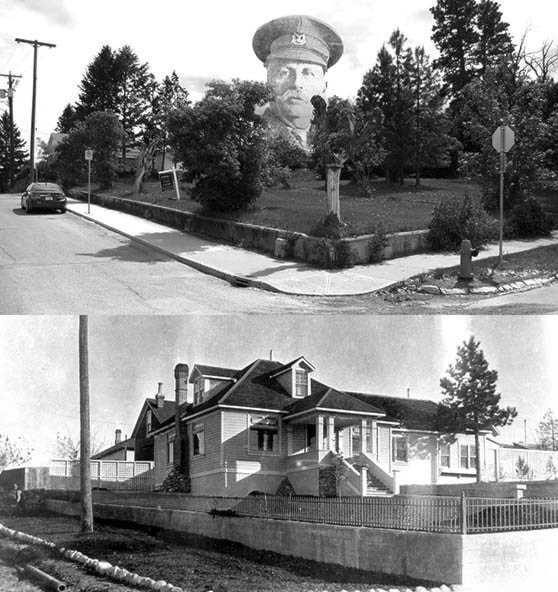Jim Cameron
On the southeast corner of Louis Street and Garden Avenue there is a large, empty lot. Well, not entirely empty. There is grass and there are trees and there is a concrete wall around part of it and a sign that would seem to indicate that it is for sale and there are two nicely constructed though slowly deteriorating rock pillars at the end of a sidewalk that leads to the middle of nothing.
If you walk up to the end of the sidewalk you will be standing at the foot of what was once stairs to a house. If you turn around and walk back down the sidewalk and down the steps and then stop and look down past your feet you will see an inscription in the concrete. It will be upside down and backwards. Move around to the other side and you will read, "W.S. Santo," stamped clear as a bell into the concrete sidewalk.
Now, you can wander all around Cranbrook and you will see City of Cranbrook stamps in sidewalks and you will find scratches and scribbles in sidewalks but it is unlikely that you will find anything like this and, since W.S. Santo died over 70 years ago, it is very unlikely that you will find one as old. And what did W.S. Santo do to have his name engraved so neatly in city cement and exactly how long has it been there? That remains open for speculation.

William Stephen Santo was born in London, Ontario, on June 25, 1863. In his younger days, it has been stated that he served as a dispatcher with General Middleton's army during the North-West Riel Rebellion of 1885. It has further been stated that he met his wife Annie — born in County Clare, Ireland — in Columbus, Ohio, from whence they travelled to British Columbia by way of mining camps in California, Colorado and Montana. There is little hard evidence. Perhaps he may have done both.
Regardless, William and Annie Santo found themselves in Fort Steele in 1897; where their daughter Lily Vigil was born, and from there moved on to operate general stores at Sand Creek, Peterborough (now Wilmer) and Canterbury (now Invermere) where they opened the town's first store in 1901. By 1906 the Santos owned the Thunder Hill Ranch at the southern end of the Upper Columbia Lake near Canal Flats.
Although mining remained a constant throughout William Santo's life, ranching did not. In 1908 he sold much of Thunder Hill to Earl Grey, the Governor General of Canada, and disposed of the remainder over the ensuing years. In 1911, the Santos moved to Cranbrook, purchased land on the corner of Louis and Garden and built a house.
Mr. Santo quickly immersed himself in community activities, joining the Agricultural Association, the Cranbrook and District Fish and Game Protective Association and the local chapter of the Masons before the year was out.
His interest in civic affairs led him to run for mayor in 1913, heading a ticket (a common practice of the day) of CPR "railroad men." It was yet another chapter in an ongoing local political battle between the railway men and the businessmen of the city, which, in short, may be better described as railway union versus business non-union. The Santo ticket was soundly defeated by the ticket of businessman Alder Bowness featuring a rather vitriolic election campaign. It brought a large turnout to the polls and left a lingering bad taste in the mouths of many.
Despite his political failure, William Santo did not abandon his support for the community, continuing with civic affairs as before. He further applied himself to the beautification of his property with a passion constructing a concrete wall and cast iron fence in 1914 and a great deal of landscaping, resulting in "... one of the most picturesque residence properties in the city," according to the Cranbrook Herald of June 4, 1914.
He once again stood for alderman in 1915 and was once again defeated. The following year he was finally successful in his bid and undertook the role of alderman as well as becoming one of three members of the local police commission. An editorial in the Herald of January 4, 1917, states "Mr. Santo's record on the police commission and council has not been such as to entitle him to a renewal of the confidence of the electorate." He was defeated in his bid for public office during the ensuing election.
Never a quitter, he once again became a member of city council (by acclamation) in 1921 and by popular vote the following year. He saved a child from drowning in Joseph Creek in April, 1922, although, perhaps not surprisingly, his effort garnered little publicity in the local news. That same year he was appointed head of the Cranbrook Government Liquor Control Board, a rather plum position and one that he held until 1929.
During his final years, William Santo secured a post with the Parks Board at Radium, for which he vacated his house in 1939. He died on May 19, 1945, at the age of 81, outliving his wife by 19 years. The Santo residence remained standing until the 1970s.
As to the inscription in the sidewalk, it would seem unlikely to have occurred after 1939, which would mean that both it and the concrete in which it is imbedded is at least 77 years old, a testament both to the man and the cement of the day.
As a final note, for those who recall the mineral cabinet outside the old Cranbrook Post Office, it was none other than W.S. Santo who collected and labeled the display in 1925.
